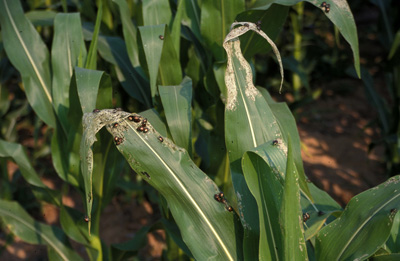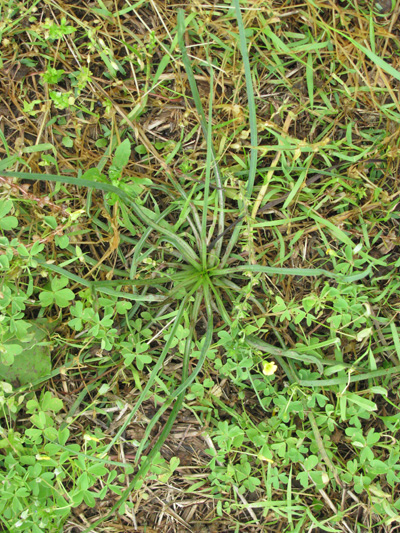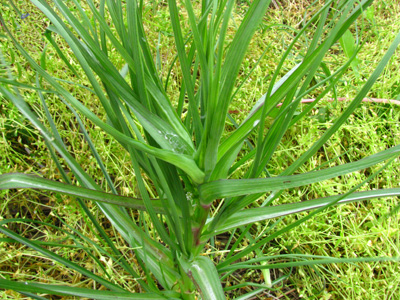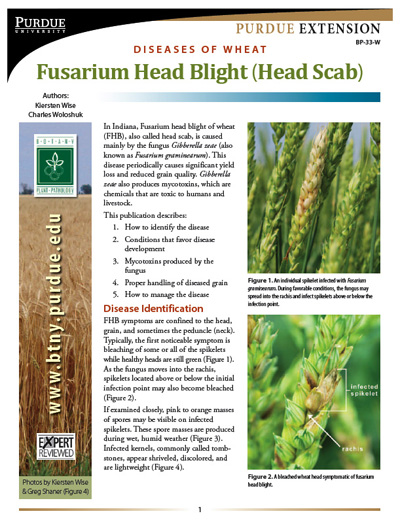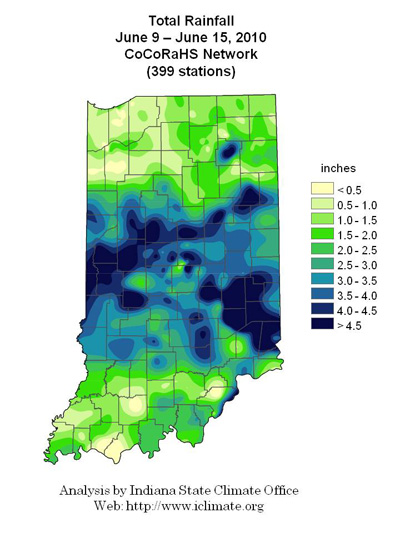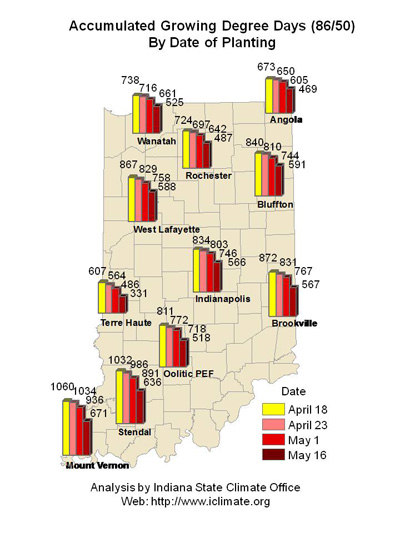Pest & Crop Newsletter, Entomology Extension, Purdue University
- Japanese Beetle Season Begins
- Video: Sampling for Corn Rootworm Larvae
- Black Light Trap Catch Report
Curious About Rootworm Damage, Now's the Time to Check - (Christian Krupke and John Obermeyer)
• Larval sampling procedures are outlined.
• Unfortunately, all the larvae have not drowned.
• Rescue treatment guidelines are given below.
A hot spring has meant crops are off to a quick start, and insects are also ahead of their usual pace. At the Diagnostic Training Center this week, we had no problem finding mature larvae, and pupae have been found at research fields in southern Tippecanoe County – meaning that we will see adults in a week or so. However, larval hatch and development will continue for some weeks to come – the rootworm emergence is a long and gradual curve, not a sharp spike like some insect populations. Initially, larvae are seldom observed because they are very small and live mostly within the roots. As they increase in size, they will feed both inside and outside roots, causing tunneling and pruning. It would be prudent at this time to sample roots of plants in high-risk fields, especially where insecticide efficacy is in question. You will be able to see both the damage and larger larvae at this time.
To sample for rootworms, use a shovel and lift out the root mass and surrounding soil and place on a dark surface (black plastic garbage bags work well). Carefully break up the clods and sort through the soil. Look for 1/4 to 1/2 inch long, slender, creamy-white larvae with brownish-black heads and tails. The largest 3rd-instar larvae look similar in size and color to a cooked grain of rice. Once the soil has been separated from the root mass, inspect it for root scarring and pruning. You may find the larvae under the leaf collars that are close to nodal roots; tear these leaves away to check. Rootworms are often observed partially sticking out of roots. Repeat the process with several plants, representing different areas of a field. An average of two or more larvae per plant represents a treatable rootworm infestation and signals the need for a rescue cultivation application. Better yet, immerse the entire root ball in a 5-gallon bucket of clean water and shake it around. After 5-10 minutes, any larvae will float to the surface and the cleaned root can be inspected for feeding damage. However, because washing roots is more effective at dislodging and revealing rootworms present in and around the roots than digging alone, an average of eight or more larvae per plant justifies a rescue insecticide treatment.
Inspecting root mass and surrounding soil for rootworms
Corn rootworm and damaged nodal roots
Rootworm larval yield from one root mass
Several comments have been made about rootworm drowning in our saturated soils. It is true that newly hatched larvae seeking corn roots will struggle when soil pores are filled with water, many potentially drowning before finding sanctuary (i.e., corn roots). Flooded soils, on the other hand, will cause anaerobic conditions, which deprives larvae from oxygen, but the corn as well. In this case, the rootworm will perish, but so will the corn.
Insecticides applied after planting should be directed toward the base of the plant. It is also important to throw soil up around plants to incorporate the insecticide and promote the establishment of brace roots. A good brace root system will help prevent plant lodging and reduce yield losses due to rootworm feeding. If a no-till field has an economic population of larvae, placing the insecticide on top of the ground will usually not be effective – these are contact insecticides and need to be directed to where the larvae are. The only exception may be if the soil insecticide is watered in through irrigation or rainfall (ideally ½” or more). Lorsban 4E, liquid insecticide, is labeled for post-emergent application. If one decides to mix the insecticide with a liquid nitrogen source for a side-dress application, compatibility checks should be made. Broadcasting the insecticide will greatly diminish efficacy.
![]()
View this video on scouting for corn rootworm larvae
![]()
Japanese Beetle Season Begins- (Christian Krupke and John Obermeyer)
- Grub feeding is mostly over, now it’s beetle time
- Watch for activity on soybean, and later on corn silks
Scattered reports of Japanese beetle adults indicate that their presence will soon be felt. Within two weeks, most areas in the state should be seeing this notorious pest in crops and around the home. The good news is that so far, the populations seem to be lower. Perhaps as a result of spring’s wet soils increasing grub mortality from pathogenic fungi. The bad news is that somewhere in the state this summer, their wrath will be felt! Oh yes, it will be felt indeed my friends.
This year’s adults are the result of eggs that were laid by female beetles last summer. After these eggs hatched, the grubs immediately begin to feed on a wide variety of roots and decaying organic matter in the soil. This feeding is typically not noticed and not economic. They continue feeding until cold temperatures prompt them to move deeper in the soil profile to overwinter. Early in spring, the surviving grubs return to near the soil surface to feed, and this is when they cause the most problems in field crops. Spring root feeding by the grubs can result in serious damage to early-planted crops, especially corn. Fortunately, we have heard of very few grub problems this year.
Japanese beetles are generalists both as adults and larvae and will feed on more than 350 different species of plants, but are especially fond of roses, grapes, smartweed, soybeans, corn silks, flowers of all kinds, and overripe fruit. Beetle damage to cultivated crops is often minimal and defoliation (leaf removal) on soybean typically looks much worse than it is, and is often most severe along borders, where “drive-by scouting” tends to occur. The beetles often congregate in several areas of a soybean field, feeding on and mating in the upper canopy. The beetles’ iridescent, metallic color also frequently catches the attention of those doing “windshield” field inspections. Closer inspection will often reveal that weeds (e.g. smartweed) have made fields even more attractive to the beetles. Look for more on this pest in future issues of Pest&Crop.
Adult Japanese beetles feeding on corn leaves
Let the party begin on soybean leaves
![]()
Click here to view the Black Light Trap Catch Report
Is This a Giant Dandelion? – (Chad Brabham, Glen Nice, Tom Jordan, and Bill Johnson)
It looks as if Johnny Appleseed’s cousin, Johnny-go-to-bed-at-noon, has been spraying fertilizers on dandelions. However, this plant is really a Salsify or Goatbeard (Tragopogon spp.). There are several species of salsify in Indiana, with Western Salsify (T. dubius Scop.) (Figure 1) and Meadow Salsify (T. pratensis L.) being the most common. Western Salsify is native to Europe and Northern Africa and brought to North America as a garden vegetable for its carrot like taproot and “oystery taste”. Since then it has spread to roadsides, old abandoned fields, no-till field, pastures and other undisturbed areas.
Figure 1. Western Salsify
Biology
Western Salsify is a dicot species that requires at least two years (biennial to short lived perennial) to produce seed. In the first year of growth leaves develop into a basal rosette that is often mistaken for a grass (Figure 2). The basal rosette has multiple long, narrow, parallel veined leaves that taper to a kneeled or pointed tip.
Figure 2. Rosette of Western Salsify
Bolting (stem growth) will eventually occur when a minimum rosette size is reached. The time to reach this criteria can range from a year to upwards of 10 years. At bolting time a smooth, round, erect stem is initiated with long, linear, grass-like leaves (8-12”) clasping to it. These leaves may or may not contain cobweb-like hairs (Figure 3).
Figure 3. Bolting stem of Western Salsify
Once bolting has occurred, an inflorescence (flower head) is borne onto a single stem. Yellow ray flowers begin to bloom in the early summer months of April, May or June. Flower bracts (small leaves at the base of the flower) surpass flowers in length and continue to elongate (Figure 4); however, in Meadow Salsify bracts do not extend past the petals. As the plants mature, large achenes (fruits) with a pappus (seed feather) attached will develop, similar to dandelion. The pappus aids in wind dispersal of seeds.
Figure 4. Flower head of Western Salsify
Keys to Identification
- Large dandelion like white puff ball seed head
- Excretes milky sap when broken
- Grass-like leaves
Management
Western Salsify is rarely a problem in crops, but can be in pastures. Early control of the basal rosette before bolting is suggested. Rosette size has been highly correlated with survivability and flowering success in the following years. Seeds of Western Salsify have little dormancy or low persistence in the seedbank. Tillage, hand pulling, mowing and/or grazing are feasible control methods. Little information is available for chemical control of Western Salsify. Recommendations of growth regulator products that contain picloram (Tordon), clopyralid (Stinger) or dicamba (Banvel, Clarity) have shown to be effective. The use of 2,4-D has shown varying results but will provide suppression. Depending on the situation and level of infestation hand pulling is what I would recommend for small areas infested with Western Salsify.
References
Anonymous. 2010. Pacific Northwest Weed Management Handbook. Oregon State University.
Clements, D. R., Upadhyaya, M. K. and Bos, S. J. 1999. The biology of Canadian weeds. 110. Tragopogon dubius Scop., Tragopogon pratensis L., and Tragopogon porrifolius L. Can. J. Plant Sci. 79.
Gross, Katerine L. 1981. Predictions of Fate from Rosette Size in Four “Biennial” Plant Species: Verbascum thapsus, Oenothera biennis, Daucus carota, and Tragopogon dubius. Oecologia, 48:2.
Tenaglia, Dan. Accessed May 28, 2010. Tragopogon dubius Scop. <http://www.missouriplants.com/Yellowalt/Tragopogon_dubius_page.html>.
Upadhyaya, M. K. et. al., 1993. Meadow Salsify and Western Salsify: Two Rangeland Weeds of British Columbia. Rangelands 15:4.
USDA, NRCS. 2010. The PLANTS Database <http://plants.usda.gov> (12 June 2010). National Plant Data Center, Baton Rouge, LA 70874-4490 USA.
Uva, R.H., Neal, J.C., DiTomaso, J.M. (1997) Weeds of the Northeast. Cornell University Press, Ithaca, NY.
Scab Strikes Again in Indiana Wheat – (Kiersten Wise)
Fusarium head blight, or scab, is present in many commercial fields in central and northern Indiana. Incidence and severity vary from field to field, and many fields that appear to look healthy from the road still have low to moderate levels of head blight in the field. Incidence (number of infected heads) ranges from 5-60% or higher in areas of central and northern Indiana. Severity (amount of infection per head) ranges from 7-40% in these areas. The Fusarium Head blight risk model <http://www.wheatscab.psu.edu> indicated that risk of infection was moderate in areas of northern Indiana during flowering, and warm, humid conditions after flowering may have allowed initial infections to progress throughout the head.
Fusarium head blight levels were much lower in southern Indiana this year, and many fields have low incidence and severity of the disease. Scouting reports from southern counties indicate that fields with late-flowering varieties did have higher levels of the disease.
Growers should be prepared to deal with DON, or vomitoxin, in fields infected with Fusarium head blight, and should scout fields now to determine the presence and level of the disease in each field. If the disease is present, increasing the fan speed on the combine at harvest can blow out the lighter scabby kernels, which contain most of the DON.
The new Purdue Extension publication Diseases of Wheat: Fusarium Head Blight (Head Scab) is available online at: <http://www.extension.purdue.edu/extmedia/BP/BP-33-W.pdf>. This publication includes information on prevention and management of the disease, as well as information on DON advisory levels for animal feed. The publication also lists laboratories in Indiana that conduct mycotoxin testing on wheat.
Click this graphic to download the new PDF publication on Fusarium head blight.
Information on Flood/Water Damage to Field Crops and Other Tidbits – (Bob Nielsen)
A reminder that there is a compilation of information from around the Midwest that deals with flood damage to field crops on our Web site at <http://www.agry.purdue.edu/ext/corn/cafe/flood/index.html>.
There is a Current Interest section that covers information on assessing Hail Damage to Young Corn <http://www.agry.purdue.edu/ext/corn/news/timeless/HailDamageYoungCorn.html>.
If there are issues not covered there that need to be addressed, please let me or other field crops specialists know.
Also, remember that contact information for our Extension field crops specialists is available at <http://www.agry.purdue.edu/ext/corn/cafe/experts.html>.
Result of severe winds and hail on cornfield, Benton County, June 14




